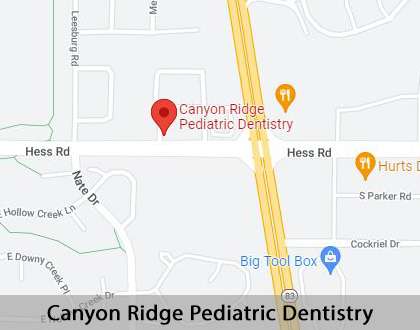Dental Sealants Parker, CO
Dental sealants are thin coatings that protect teeth from debris and bacteria that can cause cavities. Brushing and flossing is the most effective way to prevent cavities, but it can be difficult to thoroughly clean the uneven surfaces of the back teeth. While the rough premolars and molars are ideal for cavity-causing bacteria to hide, dental sealants can keep cavities from forming.
Dental sealants are available at Canyon Ridge Pediatric Dentistry in Parker and the surrounding area. Preventing cavities is a crucial part of maintaining good oral health. Call us today at (303) 841-7900 to learn more about our services or schedule an appointment.
A Popular and Effective Preventative Treatment
Both children and adults can benefit from dental sealants. However, the earlier patients get them, the better. The best time for children to receive sealants is between the ages of five to 14. Dental sealants are preventative treatments that are growing in popularity. According to the CDC, about 42% of six to 11-year-old children have a dental sealant.
While most children can benefit from these coatings, the application process requires teeth to be completely clean and dry to prevent the sealant from falling off. Patients with primary teeth can receive sealants, but they must be able to tolerate holding their mouth open and staying still for a few minutes. Treating younger teeth is usually only necessary for children with a higher risk of tooth decay. Patients with an active tongue or sensitive gag reflex may need to wait six to 12 months to allow for better cooperation if necessary.
“The best time for children to receive sealants is between the ages of five to 14.”
Long Term Benefits
When applied properly, dental sealants can provide many long-lasting benefits. The National Institute of Dental and Craniofacial Research reported that 42% of children between two and 11 had had dental caries in their primary teeth. Sealants are a quick and easy way to prevent most of the cavities children get in their permanent molars.
Sealants alter the structure of molars by making their grooves less deep and less likely to retain plaque and debris. Dental sealants should last at least three to five years but can last up to nine years with the proper care and maintenance. A CDC report states that dental sealants prevent 80% of cavities for two years after application and continue to protect against 50% of cavities for up to four years.
“Sealants are a quick and easy way to prevent most of the cavities children get in their permanent molars.”
Types of Dental Sealants
Sealants can consist of glass ionomer or composite resin. Glass ionomers undergo an acid-base reaction as they set on teeth. This coating material also releases fluoride, which helps strengthen tooth enamel for many years. While fluoride will help increase enamel’s health and strength, it has a lower retention rate than composite resin and will require more upkeep.
Composite resins undergo a polymerization reaction through the application of a curing light. They consist of a plastic compound and ceramic that blends in with the color of natural teeth. This material is strong and has a higher retention rate than glass ionomer sealants. However, as they wear down over time, composite resin sealants will not protect against cavities as well as glass ionomer sealants do.
“Sealants can consist of glass ionomer or composite resin.”
Check out what others are saying about our dental services on Yelp: Dental Sealants in Parker, CO
The Placement Process
The process of applying dental sealants is relatively fast and painless. Before we can apply the sealant, we must clean the patient’s tooth with a polishing brush and gritty toothpaste. The tooth is then dried and isolated from the tongue and cheeks to shield them from any saliva.
An etching solution disinfects the tooth and prepares it for better sealant adherence. After the tooth is rinsed and dried again, we will paint a thin bonding layer, followed by the sealant. A special curing light hardens and bonds the sealant to the tooth. Sealing each tooth only takes about one minute.
“The process of applying dental sealants is relatively fast and painless.”
Questions Answered on This Page
Q. Who can benefit from dental sealants?
Q. What are the long-term benefits of dental sealants?
Q. What are the types of dental sealants?
Q. How are dental sealants applied to teeth?
Q. How can children help their dental sealants last longer?
People Also Ask
Q. What should parents do about a suspected cavity?
Q. How do I choose a pediatric dentist?
Q. How can I help my child establish a regular dental routine?
Keeping Sealants Long-Lasting
It is important to take care of dental sealants to help them remain effective and long-lasting. Fortunately, maintaining sealants is not difficult for children. A good oral hygiene routine can keep these coatings in good condition.
Regular dental check-ups and cleanings can also extend the lifespan of this preventative treatment. Parents should also monitor their child’s diet to keep them away from foods that can damage sealants. Avoid sticky, chewy, hard, and sugary foods that can cause sealants to break. With the right care, dental sealants can protect a child’s teeth for many years to come.
“With the right care, dental sealants can protect a child’s teeth for many years to come.”
Frequently Asked Questions
Q. Are dental sealants visible?
A. Dental sealants can be clear, white, or tinted. Sealants are barely visible on teeth. Since they are only at the back of the mouth, they are only visible upon close inspection when the child opens their mouth.
Q. Are dental sealants safe?
A. Dental sealants are safe and effective. The greatest concern when it comes to the safety of dental sealants is BPA. However, the American Dental Association has reported that the amount of BPA present in sealants is minimal. Children have a higher chance of being exposed to greater amounts of BPA in their daily lives than by sealants.
Q. Are there any potential side effects of dental sealants?
A. The only potential side effect of dental sealants is a possible allergy. Luckily, these reactions are infrequent. Parents should speak with our team about any allergies their child may have.
Q. Are dental sealants a substitute for daily oral care?
A. Sealants are an important preventative measure. However, they are not a final solution or substitute for an oral hygiene routine. Children must still brush their teeth twice a day and floss at least once.
Q. What should my child do after they receive dental sealants?
A. After the sealant hardens, the appointment is complete. A benefit of dental sealants is that there are no restrictions following their placement. Children can eat and drink right away and may return to school immediately after.
Quality Pediatric Dental Services Can Transform Smiles
By visiting us as soon as possible, our team can help get your child the professional treatment they need.
Definition of Pediatric Dental Terminology
Call Us Today
Dental sealants can protect children’s teeth through their cavity-prone years. Our team at call Canyon Ridge Pediatric Dentistry can help. Call us today at 303-841-7900 to learn more about our services or schedule an appointment.
If you live in the Parker area, call 303-841-7900 for an appointment in our Parker office.
Helpful Related Links
- American Dental Association (ADA). Glossary of Dental Terms. 2023
About our business and website security
- Canyon Ridge Pediatric Dentistry was established in 2012.
- We accept the following payment methods: American Express, Cash, Check, Discover, MasterCard, Paypal, and Visa
- We serve patients from the following counties: Douglas County
- We serve patients from the following cities: Parker, Centennial, Castlewood, Southglenn, Castle Rock, and Highlands Ranch
- Healthgrades. View Background Information and Reviews
- Norton Safe Web. View Details
- Trend Micro Site Safety Center. View Details
Back to top of Dental Sealants







